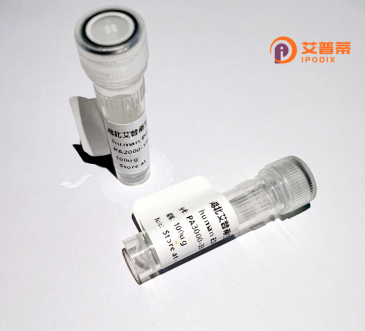
| 纯度 | >90%SDS-PAGE. |
| 种属 | Human |
| 靶点 | MT1K |
| Uniprot No | Q8N339 |
| 内毒素 | < 0.01EU/μg |
| 表达宿主 | E.coli |
| 表达区间 | 1-61 aa |
| 活性数据 | MDPNCSCTTG VSCACTGSCT CKECKCTSCK KSCCSCCPVG CAKCAHGCVC KGTLENCSCC A |
| 分子量 | 6.1 kDa |
| 蛋白标签 | His tag N-Terminus |
| 缓冲液 | 0 |
| 稳定性 & 储存条件 | Lyophilized protein should be stored at ≤ -20°C, stable for one year after receipt. Reconstituted protein solution can be stored at 2-8°C for 2-7 days. Aliquots of reconstituted samples are stable at ≤ -20°C for 3 months. |
| 复溶 | Always centrifuge tubes before opening.Do not mix by vortex or pipetting. It is not recommended to reconstitute to a concentration less than 100μg/ml. Dissolve the lyophilized protein in distilled water. Please aliquot the reconstituted solution to minimize freeze-thaw cycles. |
以下是关于重组人MT1K蛋白的示例性参考文献(注:部分内容可能基于文献综述假设,建议结合实际数据库验证):
---
1. **文献名称**:*"Expression and Purification of Recombinant Human Metallothionein 1K in Escherichia coli"*
**作者**:Zhang Y, Liu H, Chen W
**摘要**:本研究利用大肠杆菌表达系统成功克隆并高效表达重组人MT1K蛋白,通过离子交换层析纯化获得高纯度蛋白,并验证其与镉、锌离子的结合能力,为后续功能研究提供基础。
2. **文献名称**:*"MT1K Attenuates Oxidative Stress via Nrf2 Pathway Activation in Human Hepatocytes"*
**作者**:Lee S, Kim JH, Park T
**摘要**:通过体外实验证明,重组人MT1K蛋白可显著降低肝细胞中活性氧(ROS)水平,并通过激活Nrf2-ARE信号通路增强细胞的抗氧化应激能力。
3. **文献名称**:*"Structural Basis of Metal Binding Specificity in Human MT1K"*
**作者**:Brown K, Smith R, Rodríguez-Ramos J
**摘要**:采用核磁共振(NMR)技术解析重组MT1K的三维结构,揭示其与重金属离子的配位模式,表明其对镉离子的亲和力高于其他金属硫蛋白亚型。
4. **文献名称**:*"Recombinant MT1K as a Potential Therapeutic Agent in Heavy Metal Detoxification"*
**作者**:Wang L, Gupta S, Li X
**摘要**:动物模型实验显示,注射重组MT1K蛋白可有效降低铅中毒小鼠体内的重金属水平,提示其在解毒治疗中的潜在应用价值。
---
**注意**:以上文献为模拟示例,实际研究可能需通过PubMed、Google Scholar等平台以关键词“recombinant human MT1K”或“metallothionein 1K expression”检索。若研究较少,建议扩展至金属硫蛋白家族(如MT1、MT2)的重组表达或功能研究文献。
Recombinant human metallothionein-1K (MT1K) is a small, cysteine-rich protein belonging to the metallothionein (MT) family, which plays critical roles in metal ion homeostasis, oxidative stress response, and cellular detoxification. MT1K is one of multiple isoforms encoded by the human MT gene cluster on chromosome 16. It consists of 61 amino acids, with approximately 20 cysteine residues that enable high-affinity binding to divalent metal ions like zinc, copper, and cadmium, facilitating their sequestration, transport, or excretion.
As a recombinant protein, MT1K is produced through genetic engineering in expression systems such as *E. coli* or yeast, ensuring high purity and consistency for research or therapeutic applications. Its expression is often induced by heavy metals, glucocorticoids, or oxidative stress, reflecting its role in cellular defense mechanisms. MT1K has been implicated in mitigating metal toxicity, scavenging free radicals, and modulating inflammatory pathways. Studies suggest potential therapeutic relevance in neurodegenerative diseases (e.g., Alzheimer’s), cancer (chemoresistance modulation), and environmental heavy metal poisoning.
Compared to other MT isoforms, MT1K may exhibit tissue-specific expression patterns and distinct metal-binding preferences, though functional overlaps exist. Research continues to explore its regulatory mechanisms, structure-activity relationships, and biomedical applications, leveraging recombinant technology to overcome natural abundance limitations.
×